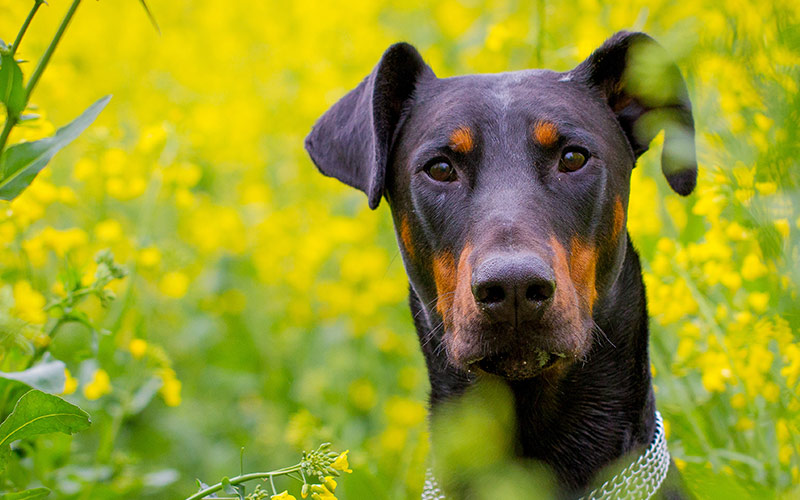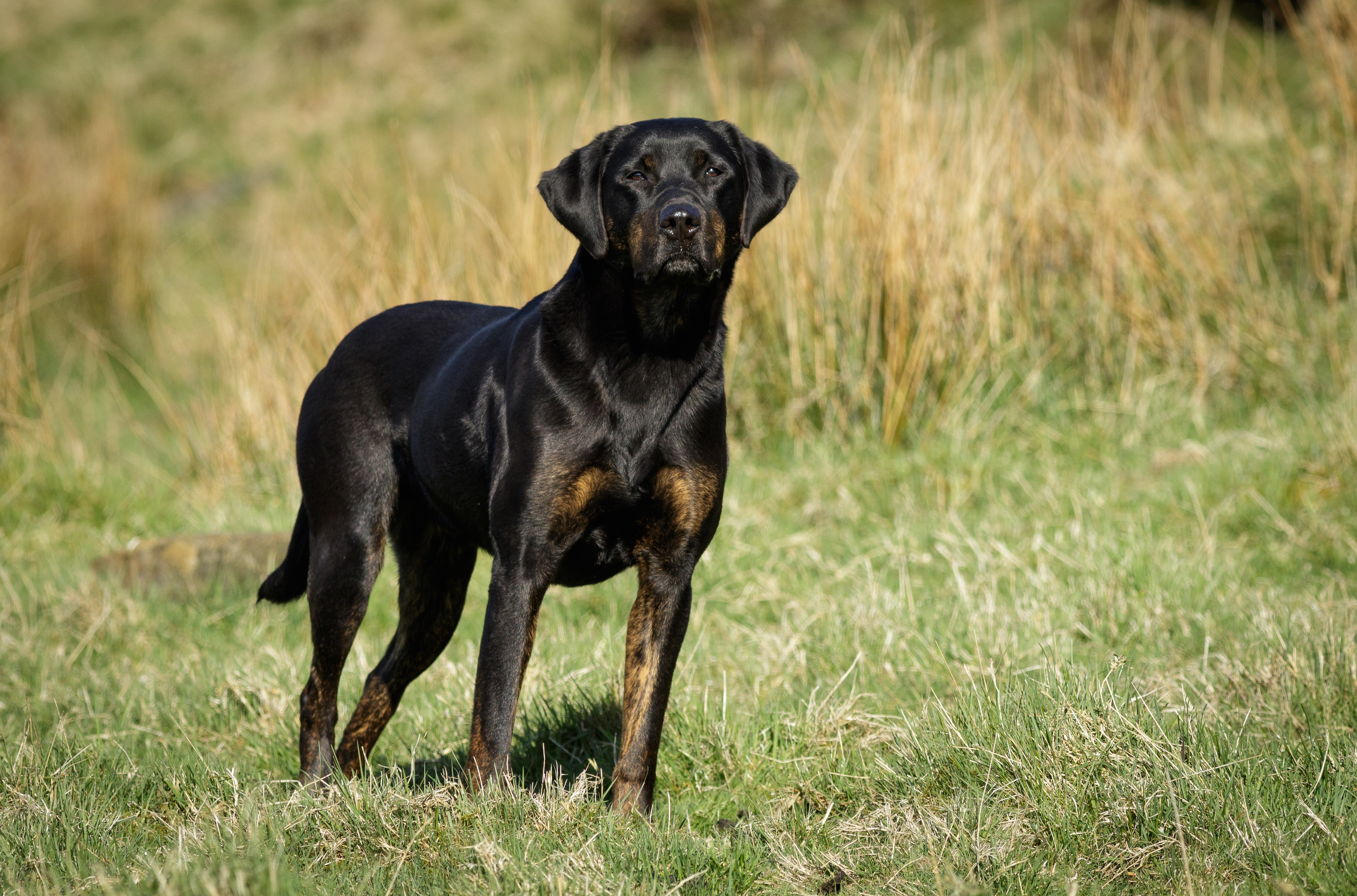In recent years, the popularity of crossbreeds has skyrocketed, with dog lovers seeking unique and fascinating combinations. One intriguing crossbreed that captures attention is the Doberman cross breed. Known for their intelligence, loyalty, and protective nature, Dobermans are already impressive dogs. But when combined with other breeds, they can exhibit a whole new set of characteristics and appearances that can be truly fascinating.
The Doberman cross breed brings together the rich history and distinct traits of the Doberman Pinscher with another breed, resulting in a unique combination. These crossbreeds can inherit a variety of traits from both parent breeds, including physical attributes and personality traits. For instance, a Doberman cross breed might have the striking appearance and agility of a Doberman, while also possessing the friendliness and sociability of the other parent breed. With their versatility and potential for diversity, Doberman cross breeds are a captivating option for dog enthusiasts looking for a unique and exceptional companion.
The Doberman is not a crossbreed but a distinct breed in itself. It was developed by a German tax collector named Louis Dobermann in the 19th century. The breed was created by crossing several dog breeds including the Rottweiler, Weimaraner, German Pinscher, and Greyhound. The result was a versatile and loyal dog known for its intelligence, strength, and loyalty. Today, the Doberman is one of the most popular breeds in the world.

Is Doberman a Cross Breed?
Doberman Pinschers are a popular breed known for their loyalty, intelligence, and protective nature. However, there is often confusion surrounding their origins and whether they are a crossbreed. In this article, we will explore the origins of the Doberman Pinscher and clarify whether they are a crossbreed or a purebred dog.
History of the Doberman Pinscher
The Doberman Pinscher, commonly referred to as Doberman, was developed by a German tax collector named Louis Dobermann in the late 19th century. Dobermann desired a loyal and protective companion to accompany him during his rounds, so he selectively bred different dog breeds to create a versatile and efficient working dog.
The exact mix of breeds used to create the Doberman Pinscher is not entirely known, but it is believed that Louis Dobermann crossed several breeds, including the Rottweiler, German Pinscher, Greyhound, Weimaraner, and possibly others. His objective was to develop a dog with a unique set of traits that would make it an excellent guard dog.
Over time, the breed evolved, and breeders refined the Doberman Pinscher’s traits through careful selection and breeding. The breed gained popularity not only as a working dog but also as a companion and family pet due to its intelligence, loyalty, and trainability.
Characteristics of the Doberman Pinscher
The Doberman Pinscher is a medium to large-sized breed, known for its sleek and muscular build. They have a short coat and come in various colorations, including black, red, blue, and fawn. Their ears are often cropped, and the tail is docked, although these practices are becoming less common due to changing attitudes towards cosmetic procedures.
Dobermans are highly intelligent and energetic dogs that require regular mental and physical stimulation. They are known for their loyalty and devotion to their families, making them excellent companions and protectors. While their protective instincts make them formidable guard dogs, they should be properly trained and socialized to ensure they exhibit appropriate behavior in various situations.
As a breed, Dobermans are generally healthy, but like any dog, they can be prone to certain health issues, including hip dysplasia, von Willebrand’s disease, dilated cardiomyopathy, and hypothyroidism. Responsible breeders conduct health screenings and select breeding pairs carefully to minimize the risk of these conditions in their litters.
The Doberman Pinscher as a Purebred
The Doberman Pinscher is recognized as a purebred dog by major dog breed registries. Organizations such as the American Kennel Club (AKC) and the Fédération Cynologique Internationale (FCI) have established breed standards for the Doberman Pinscher, which outline the desired physical and temperament traits of the breed.
While the Doberman Pinscher may have been created through crossbreeding, it has been considered a distinct and standardized breed for many years. The selective breeding efforts aimed at preserving and improving the breed’s characteristics have contributed to its recognition as a purebred.
It is worth noting that even within purebred dogs, there can be variations in appearance and temperament. This is due to individual genetic factors and differences in breeding lines. However, responsible breeders adhere to the established breed standards to ensure that the Doberman Pinschers they produce conform to the desired traits of the breed.
Advantages of the Doberman Pinscher
The Doberman Pinscher has numerous advantages as a companion and working dog:
- Excellent guard and protection instincts
- Highly trainable and intelligent
- Loyal and devoted to their families
- Alert and watchful, making them great watchdogs
- Can excel in various dog sports and activities, such as obedience, agility, and tracking
- Generally healthy and robust breed
- Can adapt to different living environments with proper exercise and mental stimulation
When considering adding a Doberman Pinscher to your family, it is essential to understand their needs, temperament, and the level of commitment required to properly care for and train them. Responsible ownership and early socialization and training are key to raising a well-adjusted and happy Doberman.
Conclusion
The Doberman Pinscher is a remarkable breed that has captivated dog lovers worldwide. Although its origins involve crossbreeding, the extensive selective breeding efforts have solidified the Doberman Pinscher as a recognized and distinguished purebred. This breed’s unique combination of intelligence, loyalty, and protectiveness makes it a popular choice for those seeking both a companion and a guardian.
Key Takeaways – Is Doberman Cross Breed?
1. A Doberman is not a crossbreed but a purebred dog.
2. Dobermans were developed in Germany by a tax collector named Louis Dobermann.
3. They are a mix of several breeds including the Rottweiler, German Pinscher, and Weimaraner.
4. Dobermans are known for their intelligence, loyalty, and protective nature.
5. It’s important to socialize and train Dobermans from a young age to ensure they are well-behaved and friendly.
Frequently Asked Questions
The following are some commonly asked questions about Doberman crossbreeds:
1. What is a Doberman crossbreed?
A Doberman crossbreed is a dog that is the result of breeding a purebred Doberman Pinscher with another breed. This leads to puppies that inherit traits from both parent breeds. Crossbreeding can introduce new characteristics and temperaments into the Doberman lineage.
When a Doberman is crossed with another breed, the resulting puppies can have a combination of physical features, such as size, coat texture, and color patterns, as well as personality traits from both breeds. It’s important to research and understand the characteristics of the specific crossbreed to ensure a good match for your lifestyle.
2. What are some common Doberman crossbreeds?
Some common Doberman crossbreeds include:
– Doberdor: Doberman and Labrador Retriever mix.
– Doberhound: Doberman and Bloodhound mix.
– Doberman Shepherd: Doberman and German Shepherd mix.
– Doberman Pitbull: Doberman and Pitbull mix.
– Doberdoodle: Doberman and Poodle mix.
These are just a few examples, and there are many other possible Doberman crossbreeds depending on the breeds used for the cross.
3. What are the advantages of owning a Doberman crossbreed?
Owning a Doberman crossbreed can offer some unique advantages:
– Hybrid vigor: Crossbreeding can result in improved overall health and resilience in the offspring.
– Diverse traits: The combination of different breeds can lead to a wider range of physical and personality traits, providing variation and uniqueness in the crossbred Doberman.
– Tailored characteristics: Crossbreeding allows for the possibility of selecting specific traits from each breed, creating a dog that aligns more closely with your preferences and lifestyle.
4. Are there any challenges with owning a Doberman crossbreed?
While owning a Doberman crossbreed can be rewarding, there are some challenges to consider:
– Uncertain traits: With crossbreeds, it can be more difficult to predict the exact characteristics and temperament of the dog, as they may vary even within the same litter.
– Health issues: Some crossbreeds may inherit health issues from their parent breeds, so it’s important to research and be aware of any potential health concerns.
– Training needs: Different breeds have different training requirements and approaches, so it’s essential to understand the needs and methods that work best for the specific crossbreed.
5. How do I choose the right Doberman crossbreed for me?
When choosing a Doberman crossbreed, consider the following:
– Research: Learn about the breed characteristics of both the Doberman and the other breed involved in the cross to understand what traits the puppies may inherit.
– Meet the parents: If possible, spend time with both parent dogs to get an idea of their temperaments and behavior. This can give you insight into the potential traits of the crossbred puppies.
– Consult with a breeder: Find a reputable breeder who can provide information and guidance specific to the Doberman crossbreed you are interested in. They can help match you with the right puppy based on your preferences and lifestyle.

So, is a Doberman a crossbreed? The answer is no, the Doberman Pinscher is not a crossbreed. It is a purebred dog breed that was developed in Germany by a tax collector named Louis Dobermann in the late 19th century.
The Doberman is a mix of several breeds, including the Rottweiler, the German Pinscher, the Weimaraner, and the Greyhound, among others. However, these breeds were selected and crossed selectively to create a new breed, the Doberman Pinscher. Today, the Doberman is recognized as a distinct and unique breed by major kennel clubs around the world.
